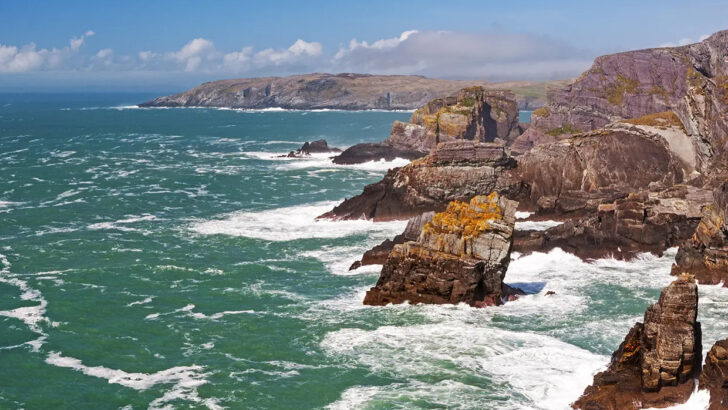The Amergin Step: An Exploration in the Imagination of Iveragh
by Paddy Bushe (Dingle Publishing Services, €30.00 / £25.00; contact Árd na Caithne, Ballyferriter, Tralee, Co Kerry; email: info@dinglepublishing.com; tel: +353 89 483 3793)
Gabriel Fitzmaurice
Paddy Bushe, one of Ireland’s outstanding poets both as Gaeilge and in English, has with this, his latest book, The Amergin Step, gifted to us a precious treasure. Beautifully written, it surveys his part of Iveragh not just topographically but also historically, mythologically, archaeologically, folklorically and geologically.
Here is a poet whose scholarship is immense, listening to the landscape, listening for the stories it tells, stories that cross barriers of language, class, literacy, stories which still inheres in the place for anybody open to listening. Listening to the landscape becomes an embodiment of story, of belief, and indeed of creative art. And in this wonderful book Paddy punctuates great scholarship with great poetry, his own and others.
Myth
Myth, he tells us, can be at least as powerful as history in informing how we see the past, the present and the future. In this light, he begins his story with the Leabhar Gabhála, with the coming of Amergin and the Milesians who landed in Ballinaskelligs Bay in the mythic past, in Ireland’s Dreamtime.
From the early medieval monastic site of Cill O Buaine he proceeds to Skellig Michael, recalling the words of George Bernard Shaw who describes it as “the most fantastic and impossible rock in the world” and laments the intrusion of Hollywood into this most hallowed of sanctuaries.
In a chapter devoted to An Glór Conallach, the Poetic Voice of the O’Connells of Iveragh, we encounter, among other poets, Ellen O’Connell (Fitzsimons), daughter of the Liberator, who in 1863 published her Darrynane in Eighteen Hundred and Thirty Two and Other Poems which serves as Paddy’s guide to Derrynane.
In writing The Amergin Step, Paddy Bushe tells us that his purpose has been redemptive – “our planet”, he writes, “is in urgent need of redemption”
I must mention here Sean Ó Conaill, the poet, not the seachai, whose poem Tuireamh na hÉireann / The Dirge for Ireland, written in the mid 1650s after Cromwell’s campaign of death and destruction, has been described as one of the most important poems ever written in Ireland.
And, of course, Eibhlin Dubh whose Caoineadh Airt Uí Laoghaire he so majestically translates and which provides a most welcome Appendix to this book. The Dubh in her name does not signify raven black hair or any dark features, rather that she is of the Ó Duibh branch of the O’Donoghues of the Glen (Glenflesk) one of whom, Séafraidh Ó Donnchadha an Ghleanna, who died in 1678, was one of our most important Gaelic poets.
Purpose
In writing The Amergin Step, Paddy Bushe tells us that his purpose has been redemptive – “our planet”, he writes, “is in urgent need of redemption…. If, like Amergin, we can imaginatively identify with – rather than simply exercise domination over – wind and sea, with falcon and flower, with stag and salmon and dewdrop, we will surely choose not to further wound ourselves”. And he concludes that “When we delve into the imaginative shaping of the places we live, we will immeasurably enrich our lives”.
The Amergin Step, published by the creative and innovative Dingle Publishing Services, includes maps and drawings by sculptor Holger Lonze and calligraphy by master calligrapher Timothy O’Neill which are brilliant as they are delightful. The Amergin Step is a joy to behold and to hold. I wholeheartedly recommend it.
Paddy Bushe is the Winner of the O’Connell Award 2024.


 Iveragh, dominated by sea, mountains and mythology
Iveragh, dominated by sea, mountains and mythology 